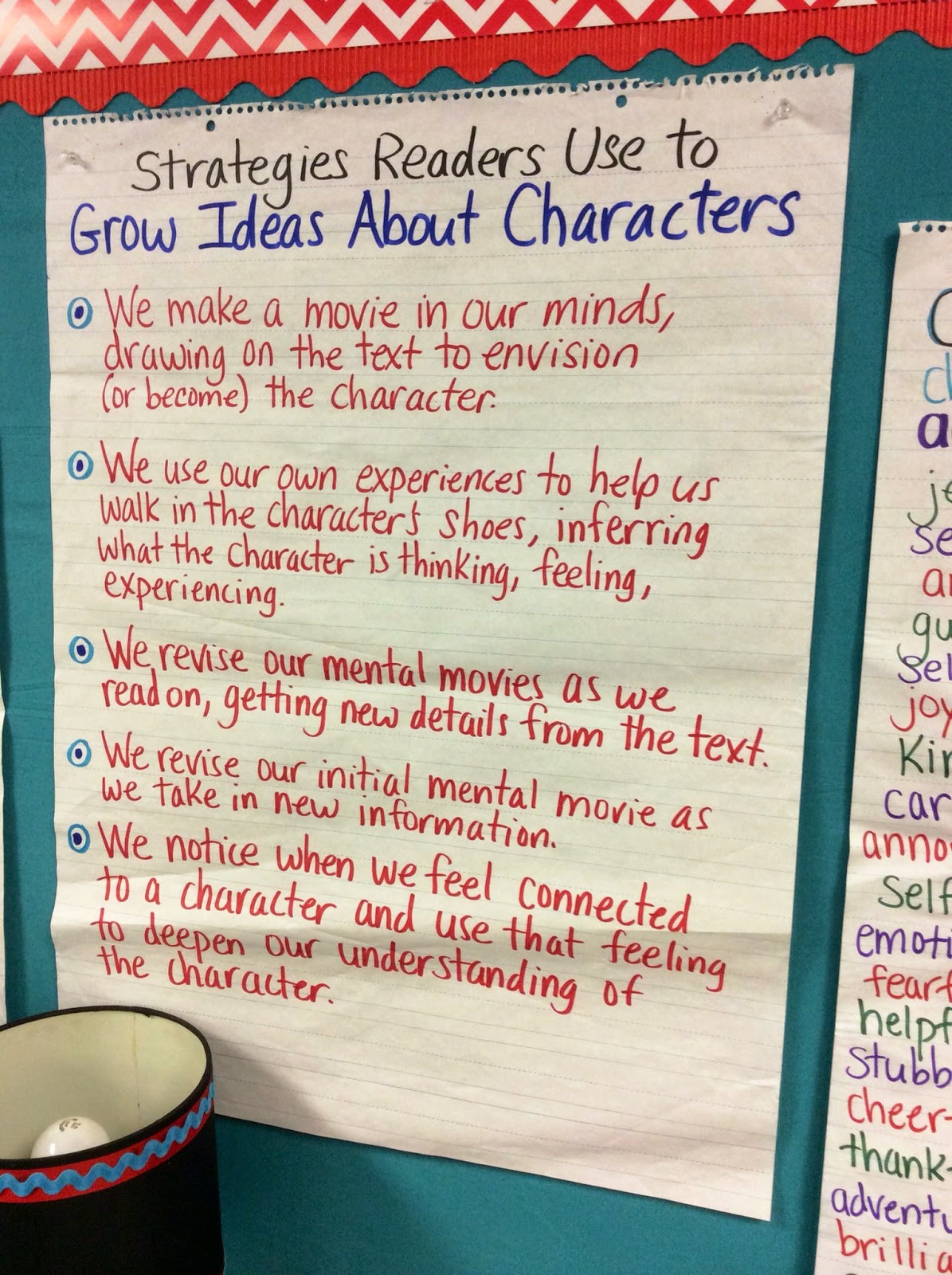The novel, Esperanza Rising, is a great fit for this particular unit and my 5th grade students because it has great characters, it has a Fountas & Pinnell reading level of V, and it is written at a 5th grade interest level. In my 5th grade classes, it is accessible to the majority of students for reading independently and for searching for text evidence for written responses.
To make the novel manageable for mini-lessons, I have broken up the chapters into two or three parts and read one part each day. This allows time for the mini-lesson, discussion, reading responses, and time for students to do their independent reading.
 |
| An anchor chart suggested by the Lucy Calkins Reading Workshop book "Following Characters Into Meaning" |
The novel also lends itself to naturally teaching about character traits, symbolism, theme, and figurative language- which are some of the reading skills that are introduced to our 5th grade students.
Character Maps
While reading Esperanza Rising, students created character maps in their Reading Notebooks. Below are some examples.
 |
| Character maps for Esperanza, Mama, and Papa. |
 |
| Character maps for Hortensia, Alfonso, Miguel, and Abuelita. |
In addition to students keeping a character map in their Reading Notebook, I create character maps on large chart paper and hang them up around the room for easy reference. I usually begin with the simple question, "What do we know about this character?" After each chapter, we can add new characters that are introduced, or add more things that we find out about a character.
Character Traits
As we studied the character's in Esperanza Rising, some of the mini-lessons focused on character traits. Students made lists of character traits in their Reader's Notebook. They practiced identifying precise words to describe a character. Students used sticky notes to jot down information about character's that were featured in their own independent reading texts. An important piece of this assignment was providing evidence to support the character trait. I asked students, "Why is the character like that?, How do you know? What evidence from the text can support your character trait?" I told students they need to prove it!
Reading Summaries
Students wrote short reading summaries in their Reading Notebook after we read each chapter. This was mainly so they could keep track of what characters are doing, how they are changing, and the main events of each chapter. It's almost like a vertical time-line of events. I started off by modeling how to write it. We first brainstormed and identified the important events of the chapter, or the section that I read that day. Then, I modeled how to write it using chart paper. I did this just a few times, then gradually released them to do it independently. After we read, we would always discuss the important parts of what was read and discuss ideas for what students could write in their quick summaries. We also took time for students to share their summaries with partners or with the class. Below are a few examples of student summaries.
 |
| Examples of reading summaries from Esperanza Rising. |
Each chapter in Esperanza Rising has the title of a fruit or vegetable. The tiles of the chapters symbolize something important in Esperanza's (the main character's) life. Below is a chart that students used to keep track of the symbolism behind each chapter.
Reading Responses
Students wrote reading responses that correlated with open-ended questions about each chapter. I used a Reading Response Checklist so students would remember to write in proper paragraph form. Below are examples of the checklist and some student responses that show their thinking about their reading.
We aren't quite finished with the book yet, but I have a few more things planned for students. After we complete the book, students will complete a comprehension test with multiple choice and essay questions. I've also thought about having them re-write the ending. This idea came to me as students were discussing the book and making predictions about what they thought was going to happen, or what they would like to happen. Writing their own ending might give them a chance to explore some of these unique ideas.
Esperanza Rising is a favorite chapter book of mine, but there are so many other books with great story lines and characters that I could use for this reading unit. I'm already thinking about what I may read to students next year. I love classic literature, but there's also so much great NEW literature that's emerging on the scene. So...I'm thinking. I'll let you know what I come up with!
Happy Reading!
-Karen






























